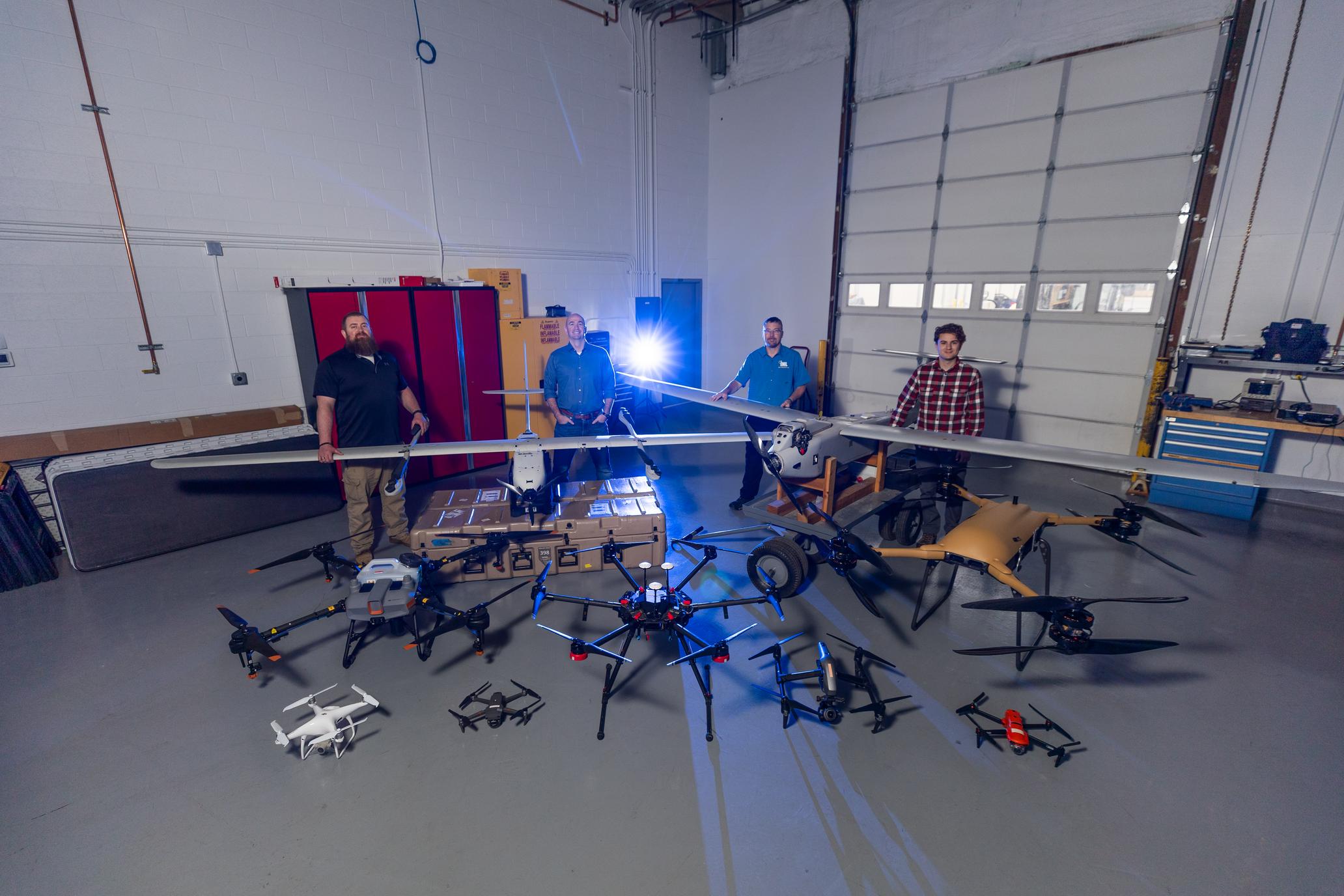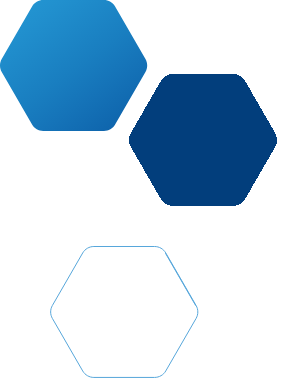Unmanned Aerial Systems
Military and Commercial Technology Solutions
Idaho National Laboratory’s Unmanned Aerial Systems program supports national security by leveraging its one-of-a-kind test-bed capabilities to test innovative technologies at scale. In the last few decades unmanned aerial systems, or drones, have evolved from large machines of military might to intelligent, agile, hand-launched aircraft. As UAS capabilities increase, so do their applications. Drones are now used for commercial applications as well as military operations. Whatever the application, drones require advanced sensors and thorough testing.
Idaho National Laboratory excels in sensor and platform testing, validation and demonstration. With hundreds of miles of open terrain, a secure boundary and state-of-the-art wireless test bed, INL is a prime location for UAS testing.
Expansive airspace, wireless test bed, explosives test range and radiological test range.
In-house testing capabilities include test design, configuration, demonstration, reset and report.
The experimental radio station status means INL coordinates frequencies over its 890-square-mile range.
Researchers can support backshift, weekend and night operations 24/7.
Labor rates include access to the airfield and range with no additional fees.
Testing and Training Capabilities
Idaho National Laboratory’s Unmanned Aerial Systems program supports national security by leveraging its one-of-a-kind test-bed capabilities to test innovative technologies at scale. In the last few decades unmanned aerial systems, or drones, have evolved from large machines of military might to intelligent, agile, hand-launched aircraft. As UAS capabilities increase, so do their applications. Drones are now used for commercial applications as well as military operations. Whatever the application, drones require advanced sensors and thorough testing.
Idaho National Laboratory excels in sensor and platform testing, validation and demonstration. With hundreds of miles of open terrain, a secure boundary and state-of-the-art wireless test bed, INL is a prime location for UAS testing.
Expansive airspace, wireless test bed, explosives test range and radiological test range.
In-house testing capabilities include test design, configuration, demonstration, reset and report.
The experimental radio station status means INL coordinates frequencies over its 890-square-mile range.
Researchers can support backshift, weekend and night operations 24/7.
Labor rates include access to the airfield and range with no additional fees.
Quick Facts
- INL’s expansive airspace, wireless test bed, explosives test range and radiological test range create a unique testing and demonstration environment.
- In-house testing capabilities include test design, configuration, demonstration, reset and report.
- The experimental radio station status means INL coordinates frequencies over its 890-square-mile range.
- INL researchers can support backshift, weekend and night operations 24/7.
- Labor rates include access to the airfield and range with no additional fees.
Quick Facts
- INL’s expansive airspace, wireless test bed, explosives test range and radiological test range create a unique testing and demonstration environment.
- In-house testing capabilities include test design, configuration, demonstration, reset and report.
- The experimental radio station status means INL coordinates frequencies over its 890-square-mile range.
- INL researchers can support backshift, weekend and night operations 24/7.
- Labor rates include access to the airfield and range with no additional fees.
For nearly three decades, INL’s 890 square mile site has provided a secure and isolated federal UAS testing environment where drone platforms and numerous sensor packages are evaluated to meet federal missions and commercial needs.
Flight Operations
The Laboratory’s federally authorized airspace covers more than 3,000 square miles of open space. It includes a variety of terrain from flat desert to high mountains and cutting-edge UAS capabilities.
UAS Test Range
Located in southeast Idaho, INL’s 890-square-mile research site provides a secure and isolated federal UAS testing environment. The laboratory has used its high-desert site for nearly three decades to test drone platforms and evaluate numerous sensor packages to meet various federal missions and commercial needs.
INL offers unique engineering capabilities to integrate military and commercial platforms with advanced sensors, electronics and communication packages. The laboratory can manufacture custom boards, chip sets and electronics on-site. INL can also carry and detonate explosives in controlled environments with world-class explosives experts.
Newly equipped drones can then be tested day or night against a host of real-world conditions found on INL’s test range including severe weather, temperature swings and long distances. Research has led to the development and integration of sensors into commercial and federal airframes to collect and transmit information. Sensors that INL researchers have developed, tested and deployed include:
- Radiation detection and mapping.
- Infrared and hyperspectral cameras.
- Real-time image analysis and composition.
- Air sampling and collection devices.
- High-bandwidth encrypted communication devices.
INL researchers can facilitate and integrate flight operations, monitoring and data transmission across an in-house wireless network with expansive capabilities to produce congested and contested communication environments. Situated in a caldera, INL’s Site includes multiple wireless towers and several mobile towers that allow for easy tower hand-off. Additional wireless capabilities include:
- Low radio frequency noise floor.
- On-site spectrum manager.
- NTIA experimental radio station.
- 2G-5G cellular communication networks.
- LTE, UMTS and GMS tier 1 carrier networks.
- WiMax, Wi-Fi, Zigbee and Bluetooth networks.
- Full fiber backhauls.
- 120db-10kHz resolution bandwidth.
- Measured spectrum 31Hz-10GHz
As a self-contained site for testing communication systems, INL has also cultivated relationships with the Federal Aviation Administration and the National Telecommunications and Information Administration that allow it to operate over almost the entire radio frequency spectrum.
Flight Operations
The Laboratory’s federal authorized airspace covers more than 3,000 square miles through mutual agreements between the Department of Energy and the Bureau of Land Management. This open Space includes a variety of terrain from flat desert to high mountains. Since 2012, INL has trained personnel, procured a large inventory of fixed and rotary wing aircraft and set up support facilities for operations.
From its 1,000-foot-by-50-foot runway and environmentally controlled 30-by-50 shelter, INL has supported more than 40 types of unmanned aerial systems aircraft using mobile control stations that incorporate power, communication, monitoring and data acquisition capabilities. Aircraft range in size from less than 1 pound to nearly 600 pounds. For most aircraft, commercial autopilots can enable full autonomous operations from takeoff to landing.
Related Information
Contact Information
Matt Balderree
Contact Information
Michelle Farrell
Quick Facts
- INL’s expansive airspace, wireless test bed, explosives test range and radiological test range create a unique testing and demonstration environment.
- In-house testing capabilities include test design, configuration, demonstration, reset and report.
- The experimental radio station status means INL coordinates frequencies over its 890-square-mile range.
- INL researchers can support backshift, weekend and night operations 24/7.
- Labor rates include access to the airfield and range with no additional fees.

Quick Facts
- INL’s expansive airspace, wireless test bed, explosives test range and radiological test range create a unique testing and demonstration environment.
- In-house testing capabilities include test design, configuration, demonstration, reset and report.
- The experimental radio station status means INL coordinates frequencies over its 890-square-mile range.
- INL researchers can support backshift, weekend and night operations 24/7.
- Labor rates include access to the airfield and range with no additional fees.


